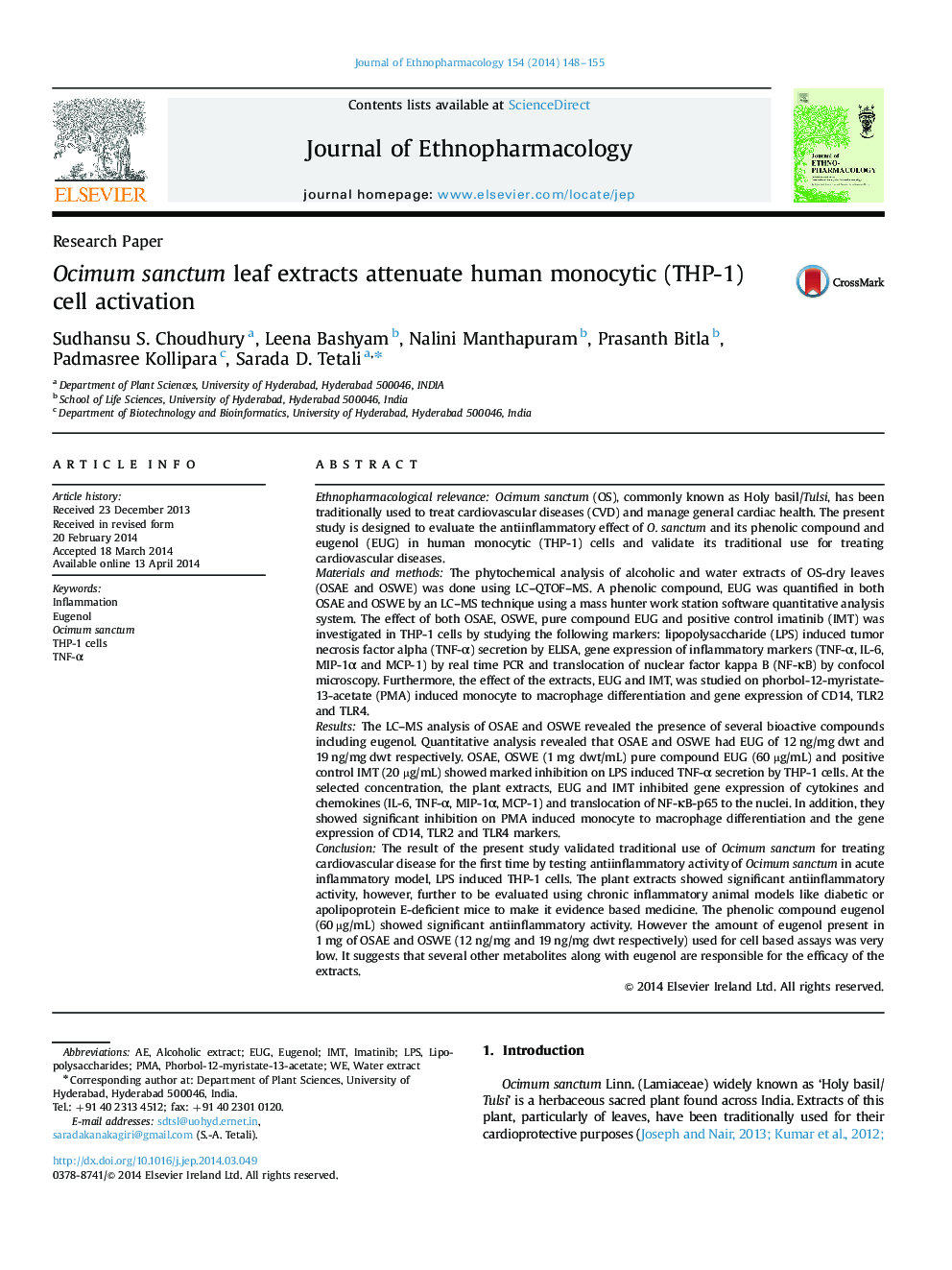| Article ID | Journal | Published Year | Pages | File Type |
|---|---|---|---|---|
| 2545189 | Journal of Ethnopharmacology | 2014 | 8 Pages |
Ethnopharmacological relevanceOcimum sanctum (OS), commonly known as Holy basil/Tulsi, has been traditionally used to treat cardiovascular diseases (CVD) and manage general cardiac health. The present study is designed to evaluate the antiinflammatory effect of O. sanctum and its phenolic compound and eugenol (EUG) in human monocytic (THP-1) cells and validate its traditional use for treating cardiovascular diseases.Materials and methodsThe phytochemical analysis of alcoholic and water extracts of OS-dry leaves (OSAE and OSWE) was done using LC–QTOF–MS. A phenolic compound, EUG was quantified in both OSAE and OSWE by an LC–MS technique using a mass hunter work station software quantitative analysis system. The effect of both OSAE, OSWE, pure compound EUG and positive control imatinib (IMT) was investigated in THP-1 cells by studying the following markers: lipopolysaccharide (LPS) induced tumor necrosis factor alpha (TNF-α) secretion by ELISA, gene expression of inflammatory markers (TNF-α, IL-6, MIP-1α and MCP-1) by real time PCR and translocation of nuclear factor kappa B (NF-κB) by confocol microscopy. Furthermore, the effect of the extracts, EUG and IMT, was studied on phorbol-12-myristate-13-acetate (PMA) induced monocyte to macrophage differentiation and gene expression of CD14, TLR2 and TLR4.ResultsThe LC–MS analysis of OSAE and OSWE revealed the presence of several bioactive compounds including eugenol. Quantitative analysis revealed that OSAE and OSWE had EUG of 12 ng/mg dwt and 19 ng/mg dwt respectively. OSAE, OSWE (1 mg dwt/mL) pure compound EUG (60 µg/mL) and positive control IMT (20 µg/mL) showed marked inhibition on LPS induced TNF-α secretion by THP-1 cells. At the selected concentration, the plant extracts, EUG and IMT inhibited gene expression of cytokines and chemokines (IL-6, TNF-α, MIP-1α, MCP-1) and translocation of NF-κB-p65 to the nuclei. In addition, they showed significant inhibition on PMA induced monocyte to macrophage differentiation and the gene expression of CD14, TLR2 and TLR4 markers.ConclusionThe result of the present study validated traditional use of Ocimum sanctum for treating cardiovascular disease for the first time by testing antiinflammatory activity of Ocimum sanctum in acute inflammatory model, LPS induced THP-1 cells. The plant extracts showed significant antiinflammatory activity, however, further to be evaluated using chronic inflammatory animal models like diabetic or apolipoprotein E-deficient mice to make it evidence based medicine. The phenolic compound eugenol (60 µg/mL) showed significant antiinflammatory activity. However the amount of eugenol present in 1 mg of OSAE and OSWE (12 ng/mg and 19 ng/mg dwt respectively) used for cell based assays was very low. It suggests that several other metabolites along with eugenol are responsible for the efficacy of the extracts.
Graphical abstractFigure optionsDownload full-size imageDownload high-quality image (139 K)Download as PowerPoint slide
